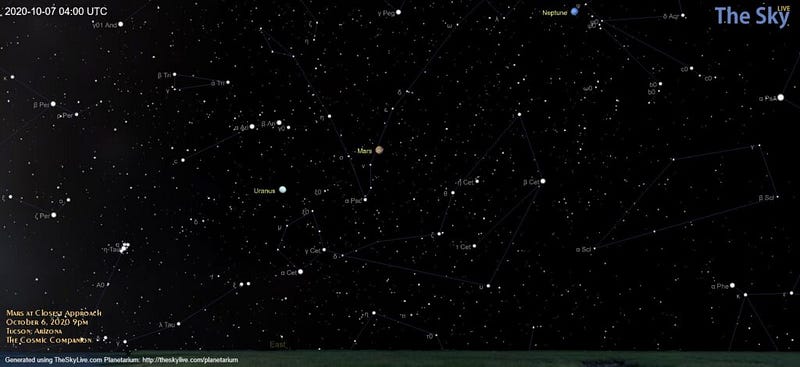Finding Mars Shining Bright in the Eastern Sky This Week
Written on
Chapter 1: The Brightness of Mars
This week, identifying Mars is a straightforward task as it radiates brilliantly in the eastern sky, presenting onlookers with a breathtaking view of the Red Planet.

As global space agencies dispatch spacecraft to Mars, stargazers on Earth are presented with a unique opportunity to witness the planet's vibrant glow in the evening sky. Image credit: PIR04D/Pixabay.
Currently, numerous spacecraft are en route to Mars, investigating the potential for water and even signs of life. However, while robotic explorers traverse the Martian surface, observers can enjoy the captivating sight of Mars illuminating the eastern horizon.
On October 6th, Mars will reach its closest point to Earth until 2035, appearing three times more luminous than the brightest star, even outshining Jupiter, making it incredibly easy to locate.

As Mars and Earth orbit the Sun, their distance fluctuates. The approach on October 6 will mark the nearest encounter between the two planets for the next 15 years. Named after the Roman deity of war, Mars has been recognized by ancient cultures throughout history. Spotting Mars in the night sky is typically straightforward if one knows where to look.
Today, we understand that the surface of Mars primarily consists of basalt, akin to Earth's ocean floors. The planet's characteristic red hue derives from iron oxide (rust), which comprises roughly a quarter of its crust. Occasionally, asteroid collisions can propel Martian rocks into space, with some eventually landing on Earth.
“The oldest Mars meteorite is ALH84001, which is estimated to be 4.1 billion years old. This rock type is classified as an orthopyroxenite and contains minerals formed through reactions with water around 3.9 billion years ago. The oldest known Martian minerals, zircons, date back 4.4 billion years and were found in a meteorite that is 2.1 billion years old,” according to NASA.
Similar to Earth, Mars features dunes and has a core surrounded by a mantle, topped with a crust. Recent research suggests that Mars may have once possessed rings that formed and subsequently vanished over time. Notable discoveries include underground lakes, ice deposits, and the intriguing possibility of life existing beneath its ruddy surface.
“We’ve got to become the Martians. I’m a Martian — I tell you to become Martians. And we’ve got to go to Mars and civilize Mars and build a whole civilization on Mars and then move out, 300 years from now into the universe. And when we do that, we have a chance of living forever.” — Ray Bradbury
Mars is easily visible to the naked eye, but even a small telescope can reveal intricate details, such as its polar ice caps. Interestingly, the northern polar region of Mars is significantly larger than the southern one, contrasting with Earth's poles.
In contrast to our planet, Mars lacks plate tectonics and has no active magnetic field. Additionally, the Martian atmosphere is incredibly thin, and the planet is orbited by two moons. While observing Mars, be sure to look east and also catch sight of Jupiter and Saturn, which are easily visible in the southwestern sky.
James Maynard is the founder and publisher of The Cosmic Companion. He is a New England native turned desert rat in Tucson, where he resides with his lovely wife, Nicole, and Max the Cat.
Did you enjoy this article? Join us on The Cosmic Companion Network for our podcast, weekly video series, informative newsletter, news briefings on Amazon Alexa, and more!
Chapter 2: Observing the Night Sky
Witness the spectacular alignment of Jupiter and Mars in the sky, as captured during an online observation session on August 14, 2024. This video provides a stunning visual of these celestial bodies coming together, a remarkable event for astronomy enthusiasts.
The second video captures beautiful mornings featuring Venus and Mars, showcasing timelapses and photographs that highlight these planets' mesmerizing appearances at dawn.
This delightful video presents the beauty of mornings with Venus and Mars, featuring timelapse sequences and stunning photographs of these planets as they grace the morning sky.